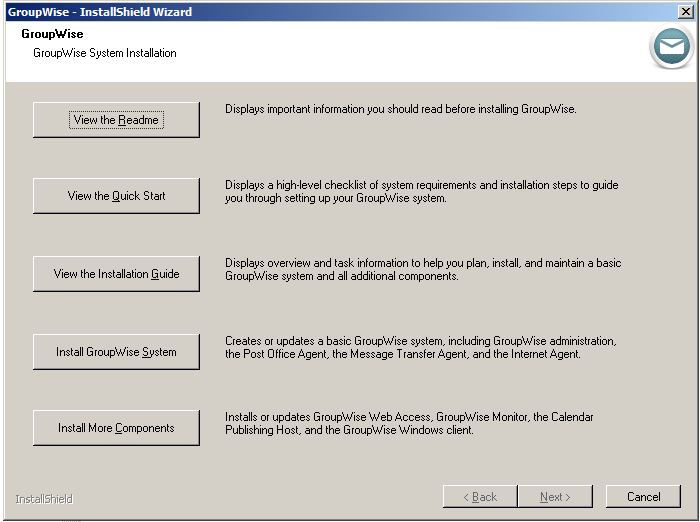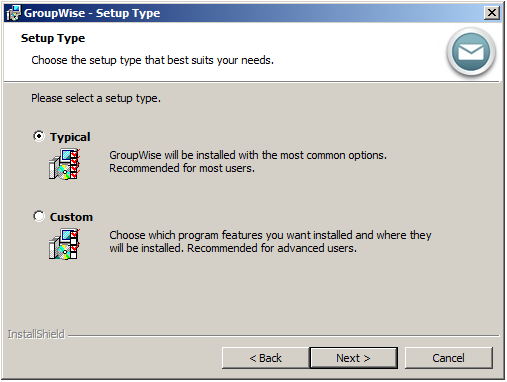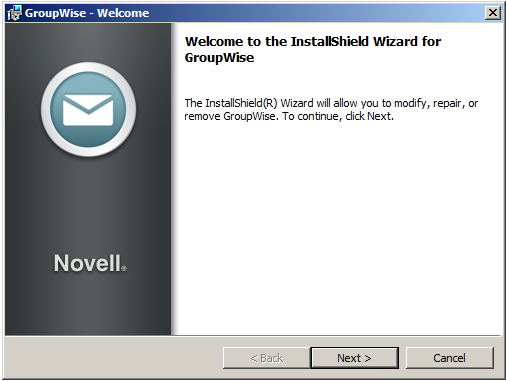9.3 Installing and Starting the GroupWise Windows Client
The GroupWise Windows client software is available in both the Windows version and the Linux version of the downloaded GroupWise 2012 software image. A simple installation of the GroupWise Windows client helps you test your GroupWise system as you are setting it up.
If you want, you can burn the GroupWise 2012 software image to DVDs for distribution to Windows client users. Advanced, system-wide rollout methods for the GroupWise Windows client are also available, as described in Distributing the GroupWise Windows Client
in Client
in the GroupWise 2012 Administration Guide.
9.3.1 GroupWise Windows Client Workstation Requirements
-
x86-32 processor or x86-64 processor
On a 64-bit processor, GroupWise still runs as a 32-bit application.
-
Any of the following Windows versions:
-
Windows XP on a 300 MHz or higher workstation with at least 128 MB of RAM
-
Windows Vista on a 1 GHz or higher workstation with at least 1 GB of RAM
-
Windows 7 on a 1 GHz or higher workstation with at least 1 GB of RAM
-
Windows 8 or 8.1 on a 1 GHz or higher workstation with at least 1 GB of RAM
-
-
Approximately 200 MB of free disk space to install the GroupWise Windows client
9.3.2 Installing the GroupWise Windows Client from the Windows GroupWise 2012 Software Image
Install the Windows client on a Windows workstation that meets the system requirements listed in Section 2.2, GroupWise User Requirements.
-
Run setup.exe from the root of the downloaded GroupWise 2012 software image.
or
If you have already copied the Windows client software to a Windows software distribution directory, run setup.exe from the root of the software distribution directory to start the GroupWise Installation program.
In order to install from the software distribution directory, users need a drive mapped to the software distribution directory. Users also require Read and File Scan rights to the drive:\grpwise\software directory to start the GroupWise Installation program and to the drive:\grpwise\software\client\win32 directory to run the Windows Client Setup program.
-
Select the language in which you want to run the GroupWise Installation program, then click .
All available languages are included in the multilanguage version of the downloaded GroupWise 2012 software image, but you can select which languages you want to install for the GroupWise Windows client.
The main GroupWise System Installation page appears.

-
Click to start the client Setup program.
-
Select the language in which you want to run the client Setup program, then click .
-
Click to display the Setup Type dialog box.

-
Select one of the following options:
Typical: Installs the most commonly used components in the standard installation directory of c:\Program Files\Novell\Groupwise without prompting for further information. By default, this installs the software integration and Internet browser mail integration. A icon is added to your desktop as well as to the Quick Launch area. However, Notify is not added to your Startup folder. This means that Notify does not run when Windows starts.
Custom: Allows you to customize the following GroupWise Windows client functionality:
-
Languages (select as needed)
-
Software Integrations (enabled by default)
-
Internet Browser Mail Integration (enabled by default)
-
Program Folder (Novell GroupWise by default)
-
Add GroupWise to the Desktop (selected by default)
-
Add GroupWise to Quick Launch (selected by default)
-
Add Notify to the Startup folder (disabled by default)
See
Using GroupWise Windows Client Custom Installation Options
inClient
in the GroupWise 2012 Administration Guide for more information about installing the GroupWise Windows client. -
-
Click .
-
(Conditional) If you selected or :
-
Click to install the client files.
When the client Setup program has completed, a shortcut to run GroupWise appears on your desktop and in the Quick Launch area.
-
Click to exit the GroupWise Installation program.
-
-
(Conditional) If you selected :
-
Make sure each component you want to install is selected.
Languages: Select which languages to install.
Software Integrations: Select the applications for integration with GroupWise Document Management Services for saving and retrieving files from GroupWise libraries.
Internet Browser Mail Integration: Sets GroupWise to be the default email program on the workstation, so that whenever the user clicks an email link on a Web page or chooses the Mail command in the browser, GroupWise starts.
-
Click .
-
Select the Program folder where you want to add the GroupWise icons.
The default is .
-
Select if you want the GroupWise icon added to your Desktop and Quick Launch.
-
Select if you want Notify added to the Startup folder. This starts Notify when Windows starts.
You can also choose to start Notify when GroupWise starts, as described in
Starting Notify When GroupWise Starts
inNotify
in the GroupWise 2012 Windows Client User Guide. -
Click .
-
Click to install the client files.
When the client Setup program has completed, a shortcut to run GroupWise appears on your desktop.
-
Click to exit the GroupWise Installation program.
-
9.3.3 Installing the GroupWise Windows Client from the Linux GroupWise 2012 Software Image
Install the Windows client on a Windows workstation that meets the system requirements listed in Section 2.2, GroupWise User Requirements. The Linux GroupWise 2012 software image includes the Windows client software.
-
On the Linux server where the Windows client software is located, set up a Samba share to provide access to the Windows client software.
If you need assistance with this task, follow the instructions for your version of Linux
-
On the Windows workstation where you want to install the WIndows client software, map a drive to the Samba share that you created in Step 1
If you need assistance with this task, follow the instructions for your version of Linux:
-
Change to the win32 subdirectory through the Samba share on the Linux server, then run setup.exe.

-
Click to begin the installation.
-
Skip to Step 4 in Section 9.3.2, Installing the GroupWise Windows Client from the Windows GroupWise 2012 Software Image to continue with the standard Windows client installation process.
Setting up Samba on OES Linux
In order to access the Windows client software on a Linux server, you can set up a Samba share to the client directory, either in the downloaded GroupWise 2012 software image or in the software distribution directory, if you have created one on the Linux server.
Configuring NetWare Core Protocol (NCP)
-
In a terminal window on the OES Linux server, become root by entering su - and the root password.
-
Enter the following command to create the NCP volume:
ncpcon create volume volume_name /directory
-
Replace volume_name with a unique name for the location of the Windows client software
-
Replace directory with the full path to the Windows client software, for example:
/opt/novell/groupwise/software/client
-
-
Verify that the volume has been created:
more /etc/opt/novell/ncpserv.conf
The new volume should be listed at the end of the NCP server configuration file.
-
Restart the Novell eDirectory daemon:
rcndsd restart
-
Continue with Installing Samba.
Installing Samba
If you installed Samba when you installed OES Linux, skip to Logging In to iManager.
If you did not install Samba when you installed OES Linux, install it now:
-
Start YaST.
-
Under , click , then click .
-
Under , select , then click .
-
Follow the prompts to install Novell Samba.
-
Continue with Logging In to iManager.
Logging In to iManager
-
Access the following URL:
https://ip_address/nps/servlet/webacc?taskid=fw StartupReplace ip_address with the IP address of the OES Linux server.
-
Specify the eDirectory administrator user name, such as admin.users.novell, the password for the user name, and the IP address of the eDirectory tree, then click .
-
Continue with Creating a User to Manage the Samba Share.
Creating a User to Manage the Samba Share
-
In iManager, click .
-
In the field, specify a unique user name for accessing the Samba share from Windows, such as gwclient.
-
In the field, provide a last name because it is a required field.
-
In the field, browse to and client the eDirectory context where you want to create the new User object.
-
Type, then retype the password for the new user.
IMPORTANT:Any users who map a drive to the Samba share need to know this user name and password in order to map the drive.
-
Click to create the Samba user for the Windows client Samba share.
-
Click to close the menu.
-
Continue with Configuring the eDirectory Universal Password for Samba.
Configuring the eDirectory Universal Password for Samba
-
Click .
-
Click .
-
On the tab, browse to and click the name of the Samba User object that you created in Creating a User to Manage the Samba Share, then click to add the user to the list.
-
Click to complete the process.
-
Continue with Setting the eDirectory Universal Password for the Samba Administrator User.
Setting the eDirectory Universal Password for the Samba Administrator User
-
Under , click .
-
Browse to and click the name of the Samba User object, then click .
-
Specify the password for the Samba user, retype the password for confirmation, then click .
-
Click to close the menu.
-
Continue with Creating a Samba Share.
Creating a Samba Share
-
Click , then click .
-
Browse to and click the name of the Server object where you are setting up the Samba share.
-
On the tab, create a new Samba share for the client directory on the Linux server:
-
Click .
-
Specify a unique name for the Samba share, such as gwclient.
-
Specify the full path name to the client directory on the Linux server, for example:
/opt/novell/groupwise/software/client
-
Select .
Write access is not required in order to install the Windows client software from the Linux server.
-
Click to add the location to the list of Samba shares, then click .
-
Click to close the menu.
-
-
Continue with Setting the eDirectory Rights for the Samba Share.
Setting the eDirectory Rights for the Samba Share
-
Click , then click .
-
Browse to and click the name of the Linux partition or directory where you created the new share, then click .
-
Click .
-
In the field, browse to and click the name of the Samba User object, then click .
-
Under , select , then click .
-
Continue with Testing Samba on the OES Linux Server.
Testing Samba on the OES Linux Server
-
Double-click the Home Directory icon on the Linux desktop.
-
Click

-
In the Location field, type smb://user_name@ip_address
-
Replace user_name with the user name of the Samba administrator user.
-
Replace ip_address with the IP address of the Linux server.
The File Browser should display all Samba shares, including the new one that you created for the Windows client software.
-
-
Return to Step 2 in Section 9.3.3, Installing the GroupWise Windows Client from the Linux GroupWise 2012 Software Image
Mapping a Drive to a Samba Share on an OES Linux Server
-
On the Windows server, right-click
 on the Windows taskbar, then click .
on the Windows taskbar, then click .
-
Select the drive letter to map to the NCP volume on the OES Linux server.
-
Specify the network path to the NCP volume in the following format:
\\linux_hostname\ncp_volume
-
Replace linux_hostname with the hostname of the OES Linux server.
-
Replace ncp_volume with the name of the NCP volume that you just created.
-
-
For the network user name, specify the fully qualified Samba user name for eDirectory., such as gwclient.users.novell.
-
Click .
-
Click .
The mapped drive to the OES Linux server opens in Windows Explorer and can now be accessed from Windows.
-
Return to Step 3 in Section 9.3.3, Installing the GroupWise Windows Client from the Linux GroupWise 2012 Software Image.
Setting Up Samba on SLES
In order to access the Windows client software on a Linux server, you can set up a Samba share on the Linux server to the client directory, either in the downloaded GroupWise 2012 software image or in the software distribution directory, if you have created one on the Linux server.
Preparing Your Firewall to Allow Samba Connections
-
In YaST, click , then click .
-
Click , select , then click .
-
Click to view the summary, then click .
-
Continue with Configuring the Samba Server.
Configuring the Samba Server
-
In YaST, click .
-
Specify a workgroup or domain name, then click .
For use in your GroupWise system, the Samba server does not need to be part of a workgroup or domain, so it does not matter what you put in this field. For example, you could use GWCLIENT.
-
Select , then click .
For use in your GroupWise system, the Samba server does not need to be a domain controller.
-
Under , select .
Because you prepared the firewall in Preparing Your Firewall to Allow Samba Connections, the section shows that the firewall port for Samba is already open.
-
Click to finish the basic configuration of the Samba server.
-
Continue with Configuring the Samba Web Administration Tool (SWAT)
Configuring the Samba Web Administration Tool (SWAT)
-
In YaST, click .
-
Select .
-
In the list, select swat, then click .
SWAT is off by default; this turns it on.
-
Click .
-
Continue with Accessing SWAT
Accessing SWAT
-
Display SWAT in your Web browser with the following URL:
http://localhost:901
-
Specify the root user name and password, then click .
-
On the SWAT toolbar, click to verify that smbd and nmbd are running.
It is not necessary for winbindd to be running.
-
Continue with Setting the Samba User Name and Password.
Setting the Samba User Name and Password
-
On the SWAT toolbar, click .
-
In the field, specify a unique user name for use when mapping a drive to the Samba share, such as gwclient.
-
Type, then retype, the password for the new user, then click .
IMPORTANT:Any users who map a drive to the Samba share need to know this user name and password in order to map the drive.
-
Continue with Creating a Samba Share.
Creating a Samba Share
-
On the SWAT toolbar, click .
-
In the field, type a unique name for the share, such as gwclient, then click .
-
In the field, specify the full path name to the client directory on the Linux server.
-
Leave the field set to the default of .
Write access is not required in order to install the Windows client software from the Linux server.
-
In the field, select .
-
Click .
The Samba share on the Linux server is now ready for access from a Windows workstation.
-
Return to Step 2 in Section 9.3.3, Installing the GroupWise Windows Client from the Linux GroupWise 2012 Software Image.
Mapping a Drive to a Samba Share on SLES
-
In Windows Explorer, right-click the Computer object, then click .
-
In the field, select the drive letter for the new Samba share.
-
In the field, specify the location of the Samba share in the following format:
\\ip_address\share_name
-
Replace ip_address with the IP address of the Linux server.
-
Replace share_name with the name of the new Samba share where the Windows client software is available.
-
-
Deselect .
-
Select .
-
Specify the Samba share user name and password, then click .
The Samba share for the OES Linux file system opens in Windows Explorer and can now be accessed from Windows.
-
Return to Step 3 in Section 9.3.3, Installing the GroupWise Windows Client from the Linux GroupWise 2012 Software Image.
9.3.4 Implementing System-Wide Windows Client Rollouts
For a system-wide rollout of the GroupWise client software, see Distributing the GroupWise Windows Client
in Client
in the GroupWise 2012 Administration Guide.
9.3.5 Starting the Windows Client
At startup, the GroupWise Windows client needs to know the location (IP address/hostname and port number) of the user’s post office. There are three ways that the client can get this information:
-
If the user is logged into eDirectory, the GroupWise client can read eDirectory for the post office’s location.
-
If the user is not logged into eDirectory, the GroupWise client can use a GroupWise name server to get the user’s post office location.
A GroupWise name server is a DNS hostname entry that defines the IP address of the post office’s POA. During startup, the GroupWise client automatically looks for the GroupWise name server in DNS. For information about creating a GroupWise name server, see
Post Office Agent
in the GroupWise 2012 Administration Guide. -
The user can provide the post office location when prompted.
To start the GroupWise Windows client for the first time:
-
Double-click the GroupWise icon on the Windows desktop.
-
Enter the password and post office address information, then click .
See also Getting Started
in the GroupWise 2012 Windows Client User Guide.